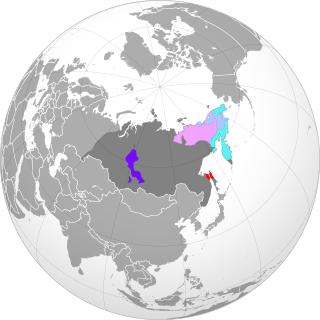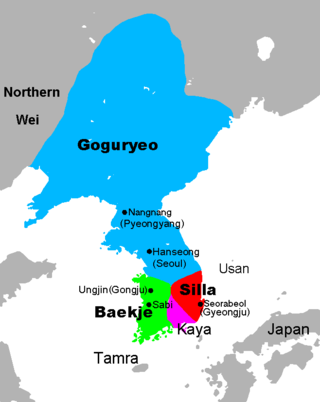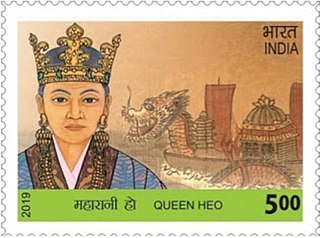Related Research Articles

The Altaic languages consist of the Turkic, Mongolic and Tungusic language families, with some linguists including the Koreanic and Japonic families. These languages share agglutinative morphology, head-final word order and some vocabulary. The once-popular theory attributing these similarities to a common ancestry has long been rejected by most comparative linguists in favor of language contact, although it continues to be supported by a small but stable scholarly minority. Like the Uralic language family, which is named after the Ural Mountains, the group is named after the Altai mountain range in the center of Asia. The core grouping of Turkic, Mongolic and Tungusic is sometimes called "Micro-Altaic", with the expanded group including Koreanic and Japonic labelled as "Macro-Altaic" or "Transeurasian".

The Dravidian languages are a family of languages spoken by 250 million people, mainly in South India, north-east Sri Lanka, and south-west Pakistan, with pockets elsewhere in South Asia.

The Paleo-Siberian languages are several language isolates and small language families spoken in parts of Siberia. They are not known to have any genetic relationship to each other; their only common link is that they are held to have antedated the more dominant languages, particularly Tungusic and latterly Turkic languages, that have largely displaced them. Even more recently, Turkic and especially Tungusic have been displaced in their turn by Russian.

The Three Kingdoms of Korea or Samhan competed for hegemony over the Korean Peninsula during the ancient period of Korean history. During the Three Kingdoms period (Korean: 삼국시대), many states and statelets consolidated until, after Buyeo was annexed in 494 and Gaya was annexed in 562, only three remained on the Korean Peninsula: Goguryeo, Baekje and Silla. The "Korean Three Kingdoms" contributed to what would become Korea; and the Goguryeo, Baekje and Silla peoples became the Korean people.

Samguk yusa or Memorabilia of the Three Kingdoms is a collection of legends, folktales and historical accounts relating to the Three Kingdoms of Korea, as well as to other periods and states before, during and after the Three Kingdoms period. "Samguk yusa is a historical record compiled by the Buddhist monk Il-yeon in 1281 in the late Goryeo Dynasty." It is the earliest extant record of the Dangun legend, which records the founding of Gojoseon as the first Korean nation. The Samguk yusa is National Treasure No. 306.

Japonic or Japanese–Ryukyuan, sometimes also Japanic, is a language family comprising Japanese, spoken in the main islands of Japan, and the Ryukyuan languages, spoken in the Ryukyu Islands. The family is universally accepted by linguists, and significant progress has been made in reconstructing the proto-language, Proto-Japonic. The reconstruction implies a split between all dialects of Japanese and all Ryukyuan varieties, probably before the 7th century. The Hachijō language, spoken on the Izu Islands, is also included, but its position within the family is unclear.

The Peninsular Japonic languages are now-extinct Japonic languages reflected in ancient placenames and glosses from central and southern parts of the Korean Peninsula. Most linguists believe that Japonic arrived in the Japanese archipelago from the Korean peninsula during the first millennium BCE. The placename evidence suggests that Japonic languages were still spoken in parts of the peninsula for several centuries before being replaced by the spread of Korean.

The Goguryeo language, or Koguryoan, was the language of the ancient kingdom of Goguryeo, one of the Three Kingdoms of Korea. Early Chinese histories state that the language was similar to those of Buyeo, Okjeo and Ye. Lee Ki-Moon grouped these four as the Puyŏ languages. The histories also stated that these languages were different from those of the Yilou and Mohe. All of these languages are unattested except for Goguryeo, for which evidence is limited and controversial.

Heo Hwang-ok also known as Empress Boju, was a legendary queen mentioned in Samguk yusa, a 13th-century Korean chronicle. According to Samguk Yusa, she became the wife of King Suro of Geumgwan Gaya at the age of 16, after having arrived by boat from a distant kingdom called "Ayuta". Her native kingdom is believed to be located in India. There is a tomb in Gimhae, South Korea, that is believed to be hers, and a memorial in Ayodhya, India, built in 2020. The Ayuta Kingdom is also considered as a misinterpretation of the Ay Kingdom, a vassal to the Pandyan Empire of the ancient Tamilakam, the predecessor of the modern-day Tamil Nadu in southern India.
Paleolinguistics is a term used by some linguists for the study of the distant human past by linguistic means. For most historical linguists there is no separate field of paleolinguistics. Those who use the term are generally advocates of hypotheses not generally accepted by mainstream historical linguists, a group colloquially referred to as "long-rangers".
The classification of the Japonic languages and their external relations is unclear. Linguists traditionally consider the Japonic languages to belong to an independent family; indeed, until the classification of Ryukyuan and eventually Hachijō as separate languages within a Japonic family rather than as dialects of Japanese, Japanese was considered a language isolate.
Susumu Ōno was a Tokyo-born linguist, specializing in the early history of the Japanese language. He graduated from the University of Tokyo in 1943, where he studied under Shinkichi Hashimoto. He was professor emeritus at Gakushuin University.
Old Korean is the first historically documented stage of the Korean language, typified by the language of the Unified Silla period (668–935).

The language of the kingdom of Baekje, one of the Three Kingdoms of Korea, is poorly attested, and scholars differ on whether one or two languages were used. However, at least some of the material appears to be a variety of Old Korean.
The traditional periodization of Korean distinguishes:

Homer Bezaleel Hulbert was an American missionary, journalist, linguist, and Korean independence activist.

Koreanic is a small language family consisting of the Korean and Jeju languages. The latter is often described as a dialect of Korean but is distinct enough to be considered a separate language. Alexander Vovin suggested that the Yukjin dialect of the far northeast should be similarly distinguished. Korean has been richly documented since the introduction of the Hangul alphabet in the 15th century. Earlier renditions of Korean using Chinese characters are much more difficult to interpret.

The geographically proximate languages of Japanese and Korean share considerable similarity in syntactic and morphological typology while having a small number of lexical resemblances. Observing the said similarities and probable history of Korean influence on Japanese culture, linguists have formulated different theories proposing a genetic relationship between them, though these studies either lack conclusive evidence or were subsets of theories that have largely been discredited. There has been new research which has revived the possibility of a genealogical link, such as the Transeurasian hypothesis by Robbeets et al., supported by computational linguistics and archaeological evidence, but this view has received significant criticism as well.

The Han languages or Samhan languages were the languages of the Samhan of ancient southern Korea, the confederacies of Mahan, Byeonhan and Jinhan. They are mentioned in surveys of the peninsula in the 3rd century found in Chinese histories, which also contain lists of placenames, but are otherwise unattested. There is no consensus about the relationships between these languages and the languages of later kingdoms.
Mioyama was one of the 12 statelets located in the Byeonhan confederacy during the Proto–Three Kingdoms period of Korea first mentioned in the Records of the Three Kingdoms. Due to its peculiar name, the statelet is used as an example of a possible placename that supports the Peninsular Japonic theory and a possible presence in Korea from ancient Japan.
References
- 1 2 3 Lee & Ramsey (2011), p. 15.
- 1 2 Hulbert (1905).
- ↑ Hulbert (1906), p. 28.
- ↑ Hulbert (1906), pp. 28–29.
- 1 2 Clippinger (1984).
- ↑ The ancient Ay kingdom was based in modern Kanyakumari) in Tamil Nadu.
- ↑ 이거룡. 2017, "가락국(駕洛國)과 고대 남인도(南印度)의 문화적 접촉에 관한 고찰: 물고기숭배를 중심으로" [A Study on the Cultural Contacts between Garak Kingdom and Ancient South India: With Special Reference to 'Fish Worship'], 인도연구, vol. 22, no. 1, pp. 85–121. doi : 10.21758/jis.2017.22.1.85
- ↑ Barnes, Gina Lee (2001). State formation in Korea: historical and archaeological perspectives. Routledge. p. 185.
- ↑ Kim, Choong-Soon (2011). Voices of Foreign Brides: The Roots and Development of Multiculturalism in Contemporary Korea. Rowman & Littlefield. p. 174.
- ↑ Ohno, Susumu (1970). The Origin of the Japanese Language. Journal of Japanese studies.
- ↑ Paek, Nak-chun (1987). The history of Protestant missions in Korea, 1832-1910. Yonsei University Press.
- ↑ Hulbert (1906), pp. 28, 300–302.
- ↑ Sohn (1999), pp. 28–29.
- ↑ Kang, Gil-un (1990). 고대사의 비교언어학적 연구. 새문사.
- ↑ Sohn (1999), p. 29.
- ↑ "Origin Theories of the Korean Language" . Retrieved 15 December 2013.
Works cited
- Clippinger, Morgan E. (1984), "Korean and Dravidian: Lexical Evidence for an Old Theory", Korean Studies, 8: 1–57, doi:10.1353/ks.1984.0011, JSTOR 23717695, S2CID 162384193.
- Hulbert, Homer B. (1905), A Comparative Grammar Of The Korean Language and the Dravidian Languages of India, Seoul: Methodist Publishing House.
- ——— (1906), The passing of Korea, New York: Doubleday.
- Lee, Ki-Moon; Ramsey, S. Robert (2011), A History of the Korean Language, Cambridge University Press, ISBN 978-1-139-49448-9.
- Sohn, Ho-Min (1999), The Korean Language, Cambridge: Cambridge University Press, ISBN 978-0-521-36123-1.
